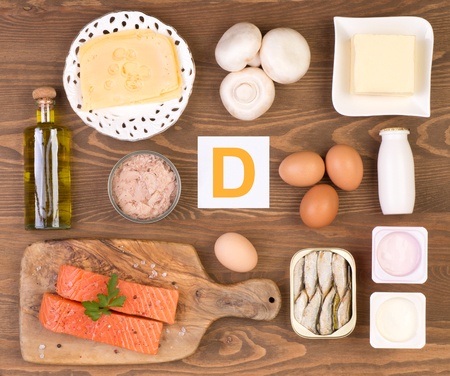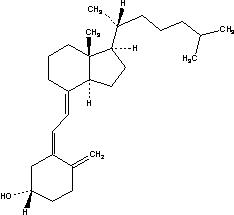
Vitamin D has many functions in the body – it regulates calcium and phosphate levels which are essential for bone building and teeth. More specifically, it is required for calcium absorption and in the process of mineralization needed for bone growth and modelling. Vitamin D is an essential vitamin.
Any absence of vitamin D in the diet and rickets develops which is a bone deformity caused by bone softening and occurs mainly in children. In adults, osteomalacia develops which is basically pain in the bone (Ceglia, 2009). There is claimed to be an association with development multiple sclerosis when levels are perpetually low.
About 1 in 5 people in the United Kingdom have low levels of vitamin D generally.
The Major Forms Of Vitamin D
The major vitamin D forms responsible for human health benefits are ergocalciferol (D2) and cholecalciferol (D3). These forms remain inactive until converted to a biologically active form called 1,25-dihydroxy vitamin D3. This occurs in the kidney and liver (Holick, 1995).
The D3 form is now regarded as the most important form and can be obtained directly from animal sources but not plants. Fish and eggs are the main sources. The D2 form is best obtained from mushrooms and fortified bread.
Natural Biosynthesis of Vitamin D Occurs When The Body Is Exposed To Sunlight
Vitamin D is an essential vitamin that is made when the body is exposed to sunlight (Holick, 1995). However, no photosynthesized vitamin D is produced in the skin for several months of the year for those who live in northern latitudes during winter, and supplementation of vitamin D is required to prevent deficiency (Calvo et al., 2004; Weaver and Fleet , 2004).
When the nights begin to draw in and the opportunity to be exposed directly to sunlight means there is less opportunity for the body to manufacture its own vitamin D [25-hydroxyvitamin D [25(OH)D]. If we are out in the sun, we only need 10 to 15 minutes each day to boost our vitamin D levels.
Most foods that we consume are low in vitamin D content. We can of course obtain small amounts from certain types of food by eating oily fish like salmon, sardines and mackerel, eggs, fish liver oils, fortified butter-like spreads, powdered milk and fortified breakfast cereals (Kutsky, 1981). It has long been the case that vitamin D supplementation is exceptionally important for vegans or others who do not eat eggs, milk or fish and literally cover themselves up. Milk is probably the most important vehicle for this type of supplementation (Yeh et al., 2017).

Fish contains roughly between 120 to 500 IU of vitamin D3 per 3-oz serving. This provides 50% to 200% of the recommended daily intake level compared to less than 25% in unfortified grains, meats, vegetables, and breakfast cereal (Holden, 2009).
Synthetic forms of the vitamin are often added to foods especially milk and confectionary milks. The vitamin is manufactured industrially by purifying 7-dehydrocholesterol isolated from animal sources and then irradiated to produce vitamin D3 (Kutsky, 1981).
Rickets
Vitamin D is extremely important – it helps in to build bones, prevents hypocalcemic seizure caused by lack of calcium and rickets, reduces the risk of diseases from cardiovascular to diabetes and cancer, and generally boosts our immunity. It is really a prohormone rather than a vitamin because it carries out its functions by acting on nuclear based receptors (DeLuca, 2004).

Rickets was always associated with poor nutrition in people suffering considerable poverty. Many children growing up in Victorian slums and the rookeries developed bowed legs and curvature of the spine. The condition was thought to have been consigned to the history books in Britain when vitamin D was added to our everyday foods such as margarine and cereal back in the 1940s. Cases of rickets dropped but then the number of children admitted to hospital has started to double relatively recently and in the past decade from 200 in 2004-05 to 455 in 2013-14.
Vitamin D & Cancer
There is gathering evidence that vit. D has a role to play in preventing cancers such as colorectal, breast and prostate (see Garland et al., 2006; Bouillon et al., 2006; Grant et al., 2007; Schwartz and Skinner, 2007).
There is some new research showing that postmenopausal women benefit from vitamin supplementation in building muscle mass as well as minimising bone loss (see post.)
The Extent Of The Vitamin D Deficiency
It seems though that many of us do not have enough vit. D in us despite the benefits. Indeed, from the evidence of a conference in 2008 on vitamin D intake, at least half the population in the USA for example are below the optimal level and 10% of children are classified as deficient in the vitamin (Brannon et al., 2008). If the serum level is below 20 nmol/l, the deficiency can lead to rickets and osteoporosis. Levels above this are less debilitating, coloured by the fact that the optimum level for everyone is not clear because it is a multi-factorial situation. Some researchers think 60 nmol/l in the blood is too little because of the impact this vitamin creates in the body. Medics test blood serum levels, and are prescribing supplements to counter any deficiency. The supplement business is worth nearly $250 million in the USA based on some 2011 figures because about 1 in 5 citizens take vitamin D in some form or other.
Questions Over Supplementation
Recent reports have questioned whether vit. D supplementation is worth it. A number of observational studies have highlighted how high vitamin D supplementation reduces the risk of cardiovascular disease by up to 58%, diabetes by 38% and colorectal cancer by 33%. However, clinical trials with vitamin D supplementation did not show a clear reduction in risk, even in those with low vitamin D levels to begin with. Likewise, assessment of supplementation in randomised trials found no positive effect on preventing these diseases. A very recent report suggests that vitamin D supplementation is not required for healthy adults (Autier et al., 2014). They conducted a meta-analysis on over a hundred studies which complemented similar work on vitamin D supplementation on bone mineral density (BDM).
One of the issues on deciding on how much vitamin D is good for you, is the scarcity of intervention studies which compare supplementation with vitamin and a placebo. It is still not clear whether overdosing might be a health issue too. One study, the VITamin D and OmegA-3 triaL (VITAL) which is assessing the link between vitamin D intake and improvements to cardiovascular health suggests the pills are not needed. If serum vitamin D levels can be improved by just being briefly outdoors, say an extra 20 minutes for example to increase exposure to the sun, then we are doing ourselves a lot of good.
Continuing Advice On Vitamin D
The Scientific Advisory Committee on Nutrition (SACN) which advises the government on nutrition is reviewing vitamin D for all population groups in the UK. This short post doesn’t do justice to the great wealth of date available and I will be adding pertinent information as it appears. I’d be interested to know others thoughts on whether they take vitamin D in whatever form, as a supplement and whether they perceive it has done them some good.
If you are interested in supplemental forms, please refer to our page on vitamin D3.
References
Bouillon, R., Carmeliet, G., Daci, E., Segaert, S., Verstuyf, A. (1998) Vitamin D metabolism and action. Osteoporos. Int. 8: S13–19.
Calvo, M.S., Whiting, S.J. (2003) Prevalence of vitamin D insufficiency in Canada and the United States: importance to health status and efficacy of current food fortification and dietary supplement use. Nutr. Rev. 61 pp. 107–13
Calvo, M.S., Whiting, S.J., Barton, C.N. (2004) Vitamin D fortification in the United States and Canada: current status and data needs. Am. J. Clin. Nutr. 80 pp. 1710–6.
Ceglia, L. (2009) Vitamin D and its role in skeletal muscle. Curr. Opin. Clin. Nutr. Metab. Care 12 pp. 628–633
Garland, C.F., Garland, F.C., Gorham, E.D., Lipkin, M., Newmark, H., Mohr, S.B., Holick, M.F. (2006) The role of vitamin D in cancer prevention. Am. J. Public Health 96 pp. 252–61
Grant, W.B., Garland, C.F., Gorham, E.D. (2007) An estimate of cancer mortality rate reductions in Europe and the U.S. with 1,000 IU of oral vitamin D per day. Recent Results Cancer Res. 174 pp. 225–34
Holden, J. (2009) USDA national nutrient database. Available from: http://www.nal.usda.gov/fnic/foodcomp/search/. Accessed 6th June 2017.
Holick, M.F.( 1995) Defects in the synthesis and metabolism of vitamin D. Exp. Clin. Endocrinol. Diab. 103 pp. 219–27
Kutsky, R.J., editor.(1981) Vitamin D. Ch. 17. In: Handbook of Vitamins, Minerals and Hormones. Van Nostrand Reinhold Co.: New York, N.Y. p 191.
Schwartz, G.G., Skinner, H.G. (2007) Vitamin D status and cancer: new insights. Curr. Opin. Clin. Nutr. Metab. Care 10(1) pp. 6–11
Weaver, C.M., Fleet, J.C. (2004) Vitamin D requirements: current and future. Am. J. Clin. Nutr. 80 pp. 1735–9
Yeh, E.B., Barbano, D.M., Drake, M-A. (2017) Vitamin Fortification of Fluid Milk. Concs. Rev. Hypoth. Food Sci., 82 (4) pp. 856-864 DOI: 10.1111/1750-3841.13648
Revised 8th June 2017




Leave a Reply